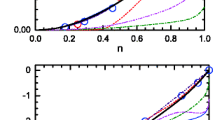Abstract
The effective mass of bound polaron in an anisotropic quantum dot is calculated by using improved linear combination operator method. Under the influence of Rashba spin–orbit interaction, the effective mass of the polaron splits into two branches on the basis of zero spin. The effective mass of bound polaron is an increase function of electron–phonon coupling strength and Coulomb bound potential strength, and a decreasing function of velocity, transverse and longitudinal confinement lengths. The relations between the spin splitting effective mass and the velocity, transverse confinement length, longitudinal confinement length, electron–phonon coupling strength and Coulomb bound potential strength are also studied by us. Due to the heavy hole characteristics, the spin splitting effective mass is negative.








Similar content being viewed by others
References
E.I. Rashba and A.I.L. Efros Phys. Rev. Lett. 91 126405 (2003)
S.A. Wolf et al., Science 294 1488 (2001)
J. Li.u, J.-L. Xiao, S.-F. Huo and Z.-Y. Chen Commun. Theor. Phys. 48 930 (2007)
A. Noiri et al., Appl. Phys. Lett. 108 153101 (2016)
A. Hofmann et al., Phys. Rev. Lett. 119 176807 (2017)
R. Ferdous et al., Phys. Rev. B 97 241401 (2018)
D. Chevallier et al., Phys. Rev. B. 97 045404 (2018)
P. Mokhtari, G. Rezaei and A. Zamani Superlatt. Microstruct. 106 1 (2017)
H.-R. Zhang and J.-L. Xiao Chin. J. Lumi. 31 12 (2010)
S.-P. Shan and S.-H. Chen Iran J. Sci. Tech. Tran. Sci. 41 755 (2017)
J. Lee and H.N. Specror J. Appl. Phys. 99 113708 (2006)
B. Vaseghi, G. Rezaei and M Malian Opt. Commun. 287 241 (2013)
F. Chi and L.-L. Sun Chin. Phys. Lett. 33 117201 (2016)
Y.-J. Chen, C.-F. Cui and H.-T. Song, Phys. E 111 130 (2019)
R. Khordad Superlatt. Microstruct. 110 146 (2017)
L. Hong, J. Ge, S. Shuang and D.-K. Liu Acta Phys. Sin. 71 016301 (2022)
S.-P. Shan and S.-H. Chen J. Low Temp. Phys. 197 370 (2019)
W.P. Li, J.W. Yin, Y.F. Yu and J.L. Xiao J. Low Temp. Phys. 160 195 (2010)
J. W. Yin, W. P. Li, Y. F. Yu and J. L. Xiao J. Low Temp. Phys. 163 53 (2011)
S.-S. Li and J.-B. Xia Nanoscale Res. Lett. 4 178 (2009)
E. Lipparini, M. Barranco, F. Malet and M. Pi, Phys. Rev. B 74 115303 (2006)
S.P. Shan and S.H. Chen Pramana-J. Phys. 94 15 (2020)
J.P. Stanley et al., Phys. E, 20, 433 (2004)
S. Jin, H. Wu and T. Xu Appl. Phys. Lett. 95 132105 (2009)
A. Hofmann et al., Phys. Rev. Lett., 119, 176807 (2017)
J.-X. Xiong, S. Guan, J.-W. Luo and S.-S. Li, Phys. Rev. B, 108, 085309 (2021)
T.-N. Xu, H.-Z. Wu and C.-H. Sui Acta Phys. Sin. 57 7665 (2008)
Z.-J. Qiu et al., Acta Phys. Sin. 53 1186 (2004)
Y.-J. Chen, C.-F. Cui, W.-F. Liu and F.-L. Shao Int. J. Theor. Phys. 59 1829 (2020)
S.-P. Shan, S.-H. Chen and J.-L. Xiao J. Low Temp. Phys. 175 523 (2014)
N. Tokuda, J. Phys.C: Solid St. Phys. 13 L851 (1980)
Author information
Authors and Affiliations
Corresponding author
Additional information
Publisher's Note
Springer Nature remains neutral with regard to jurisdictional claims in published maps and institutional affiliations.
Rights and permissions
Springer Nature or its licensor (e.g. a society or other partner) holds exclusive rights to this article under a publishing agreement with the author(s) or other rightsholder(s); author self-archiving of the accepted manuscript version of this article is solely governed by the terms of such publishing agreement and applicable law.
About this article
Cite this article
Shan, SP. Influence of Rashba spin–orbit interaction on the effective mass of bound polaron in an anisotropic quantum dot. Indian J Phys (2024). https://doi.org/10.1007/s12648-024-03113-7
Received:
Accepted:
Published:
DOI: https://doi.org/10.1007/s12648-024-03113-7




